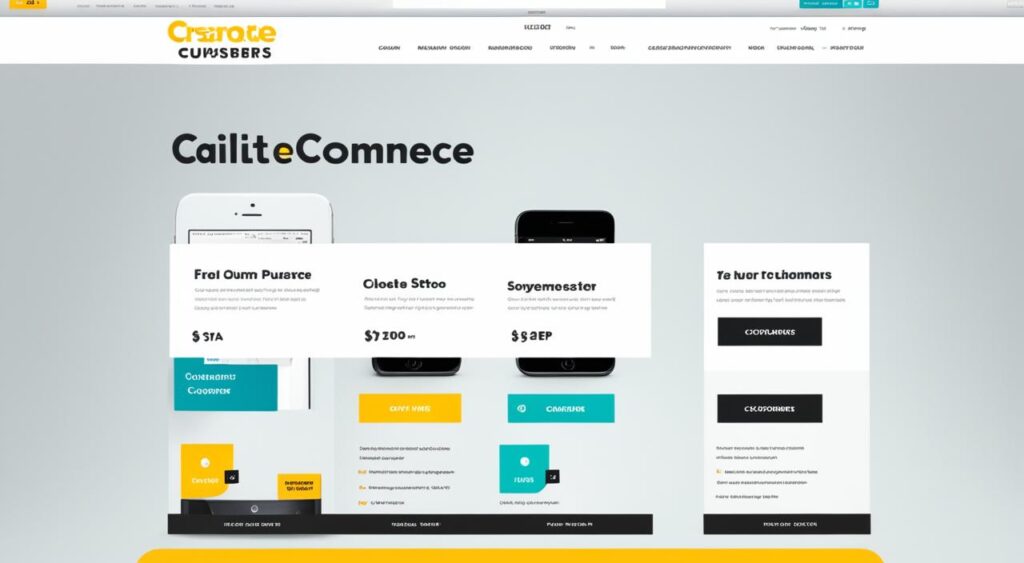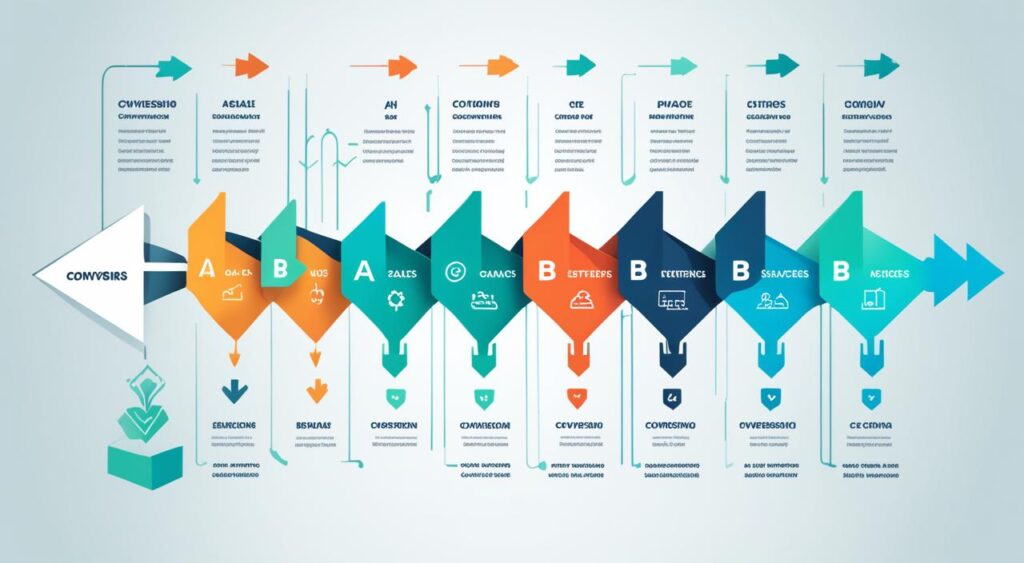In a bustling digital marketplace, a website is not just an online brochure; it’s a living, breathing salesperson working around the clock. But what if your digital advocate isn’t performing as well as it could be? Imagine walking into a store with the intention to buy, only to be met with convoluted aisles and unclear signage. It’s frustrating and may send you straight to the competition. This is where Conversion Rate Optimization (CRO) comes into play. It’s like a meticulous store manager fixing the layout, ensuring that every potential customer not just enters the shop but also makes a purchase. By implementing CRO, you can increase website conversions, transforming visits into revenue and visitors into lifelong patrons. As you dive into the world of CRO, understand that it’s a journey to improve your conversion rate, enhancing the user’s path from ‘just browsing’ to ‘order placed’.
Now, before delving deeper into the technicalities, let’s pause and reflect on the gravity of what CRO truly offers; suppose you have a 2% conversion rate, and through CRO, you manage to uplift that to 4%. It appears to be a modest increase, but in reality, you’ve just doubled your sales without increasing traffic – that is the compelling potency of conversion rate optimization. So, join us as we unfold how to harness this potential and maximize your online sales.
Key Takeaways
- Understanding CRO’s role in transforming website visits into profitable actions.
- Strategies to improve conversion rates will be pivotal to your online success.
- Increasing website conversions isn’t just about quantity of traffic, but quality of experience.
- Learn how CRO fundamentally reshapes your approach to online sales.
- Identify how leveraging CRO best practices can significantly impact your bottom line.
- Discover various tools and technologies that aid in achieving better CRO outcomes.
Understanding the Fundamentals of Conversion Rate Optimization (CRO)
Embarking on the journey of Conversion Rate Optimization (CRO) unlocks the potential to dramatically uplift your website’s performance. By refining the path to conversion, you craft a digital environment geared towards facilitating the actions that contribute to your business’s growth.
At its core, CRO is about understanding user behavior and optimizing your digital space to encourage positive actions—a practice that can transform casual visitors into committed customers.
What is Conversion Rate?
A conversion rate, in the realm of digital marketing, is the compass that guides your online strategy. It’s a measure, typically expressed as a percentage, reflecting the proportion of visitors who take a significant action on your site out of the total number of visitors. Tracking this rate is essential; it quantifies the success of your site and forms the basis of CRO initiatives.
Key Components of CRO
Several critical components frame the structure of CRO, each vital in steering website conversion rates in a positive direction. These include:
- A/B testing: This technique pits two versions of a page or element against each other to determine which yields better results.
- User Experience (UX) design: It focuses on creating an intuitive and enjoyable interaction between the user and your product or service.
- Persuasive copywriting: The art of using words to nudge the reader towards taking a desired action, employing tactics that resonate on a psychological level.
The Importance of CRO in your Sales Strategy
Your sales strategy is the blueprint for business success, and CRO is a foundational element. Conversion rate experts agree that by honing in on best practices for CRO, you can transform your digital touchpoints into conversion magnets. It’s not just about traffic; it’s about creating a user journey so compelling that visitors can’t help but become customers. Integrating CRO with your sales strategy crystallizes the path from prospect to purchaser, aligning with the ultimate objective of boosting your bottom line.
Strategies to Improve Your Website Conversion
Enhancing your website’s capacity to convert visitors into customers is pivotal for any online business. By focusing on conversion rate optimization (CRO), you tap into a range of methodologies geared towards improving the performance of your site. This involves a dynamic approach, including A/B testing and personalization, that adapt to the evolving needs of your users and the digital marketplace.
One of the first steps is to refine your landing pages. They are the digital front doors to your business, and their clarity and impact are crucial for engaging potential customers. Personalizing the user experience is another game-changing strategy. When you adapt your website to the unique behaviors and preferences of your visitors, you create a more relevant and compelling user journey, encouraging them to take action.
However, no single change can guarantee better conversion rates, which is why A/B testing is an essential part of the process. This method allows you to compare different versions of your web pages to determine which elements resonate best with your audience. Continuous iteration based on A/B testing results is a cornerstone of conversion rate best practices, as it creates a roadmap for ongoing improvement and better user experiences.
Below is a table of strategies that can guide you in elevating your website’s performance:
| Strategy | Description | Expected Impact |
|---|---|---|
| Optimize Landing Pages | Improve clarity, messaging, and visual appeal of entry points | Higher engagement, reduced bounce rates |
| Personalize User Experience | Customize content based on user data and behaviors | Increased relevance, improved user satisfaction |
| Implement A/B Testing | Compare different versions of web elements to find what works best | Data-driven enhancements, higher conversion rates |
| Continual Iteration | Regularly update and refine website elements | Steady growth in effectiveness and efficiency |
To truly stand out and keep your conversion rates on an upward trajectory, staying informed about conversion rate best practices and integrating those findings into your CRO strategy is vital. Develop a mindset of constant optimization, paired with a keen understanding of your target audience, and watch as your website becomes a powerhouse for conversions.

Conversion Rate Optimization Best Practices for E-Commerce
When aiming to enhance your e-commerce sales, it’s critical to focus on conversion rate optimization best practices that can lead to more successful transactions. Mastering the following methods can significantly uplift your customer experience and conversion rates.
Design Elements That Drive Conversions
Your online store’s design is more than just aesthetics; it’s a powerful tool that can persuade and influence buyer decisions. To maximize the effectiveness of your e-commerce site:
- Utilize color psychology to provoke certain emotions and actions. For instance, red can evoke a sense of urgency, while blue can instill trust.
- Implement a clean page layout that guides visitors smoothly from landing pages to product pages and finally to checkout.
- Create a visual hierarchy that draws attention to key sales drivers, including special offers and bestsellers.

Creating Effective Calls-to-Action
An impactful call-to-action (CTA) is not just a button on your page; it’s the gateway to conversions. Your CTAs should:
- Stand out with a contrasting color or design to draw immediate attention.
- Contain action-oriented text that compels users to take the next step, such as “Buy Now” or “Get Started”.
- Be placed strategically throughout your site to guide users seamlessly on their buyer journey.
Optimizing the Checkout Process
A streamlined checkout process can significantly reduce cart abandonment and enhance conversion rates. To refine your checkout:
- Offer a guest checkout option to accommodate users who prefer a quick purchase without account creation.
- Minimize form fields to only the essentials to simplify the transaction process for the user.
- Provide clear and transparent information about shipping costs and return policies to build trust and confidence in your customers.
By adopting these conversion rate best practices, you position your e-commerce platform to convert browsers into buyers effectively, boosting your overall sales and ROI.
Conversion Rate Optimization Tools and Technologies
To elevate your online business, embracing the right conversion rate tools and technologies is paramount. These resources give you the insights and capabilities to refine your strategies and enhance user experiences. Here’s a closer look at the advanced tools that can assist you in maximizing your conversion rate optimization (CRO) outcomes.
Analytics and Heatmap Tools
Understanding your audience’s behavior on your website is crucial, and this is where analytics and heatmap tools come into play. They provide a visual representation of where users click, scroll, and spend their time on your pages. This data is invaluable for identifying patterns, improving site navigation, and ultimately making data-informed decisions to boost your conversion rates.
A/B and Multivariate Testing Tools
When it comes to fine-tuning your website, A/B testing and multivariate testing tools are indispensable. They help you experiment with different elements of your site to see which version drives better results. Whether it’s changing a call-to-action button, modifying a page layout, or testing different headlines, these tools take the guesswork out of website optimization by providing concrete, actionable results.
User Feedback and Survey Solutions
Gathering user feedback is essential for understanding customer satisfaction and identifying areas for improvement. Utilizing survey solutions to collect insights directly from your audience can highlight what’s working and what’s not, giving you a clear direction for future enhancements. Implementing changes based on this feedback can be a powerful way to increase trust and conversion rates.
| Feature | Benefits | Impact on Conversion Rate |
|---|---|---|
| Analytics Tools | Deep dive into user data for improved targeting | Optimize user experience based on real-world behavior |
| Heatmap Software | Visual insights into user interaction with your site | Enhance areas of interest and remove friction points |
| A/B Testing Platforms | Objective analysis of different website elements | Implement the most efficient version for improved conversions |
| Multivariate Testing Tools | Simultaneous testing of multiple variables | Discover the best combination of site elements to maximize conversions |
| Survey Solutions | Direct feedback from users to address specific needs | Align website offerings with customer expectations |
In the ever-evolving digital landscape, keeping a pulse on the latest conversion rate tools is not just beneficial; it’s imperative for staying competitive. Assess and employ these technologies to ensure that your CRO efforts are as effective as they can possibly be.
Conclusion
As we navigate the dynamic landscape of online commerce, it’s evident that conversion rate optimization (CRO) is not just a tactic but a dedicated journey towards achieving measurable success. Your digital storefront requires constant refinement and optimization to ensure that visitors are seamlessly transitioning from casual browsers to confirmed customers. By focusing on strategies to improve conversion rate, you forge a path toward growth that is both sustainable and responsive to customer behavior.
Embracing the depth of CRO stretches beyond one-time changes; it involves a cycle of testing, learning, and enhancing user experience to increase website conversions. The arsenal of best practices, innovative tools, and technologies discussed in this article serves as your roadmap to unlocking your website’s full potential. Remember, CRO is not a static goal but an evolving target that adapts as your audience and their expectations shift.
As we draw the curtains on this discussion, remember that your unique site statistics and user engagement patterns are the compass that should guide your CRO efforts. The insights you have gained are valuable, but they are most potent when tailored to the nuances of your online venture. Armed with the knowledge of conversion rate optimization, set forth to refine your digital touchpoints and witness a substantial uplift in your sales outcomes.
FAQ
What exactly is Conversion Rate Optimization (CRO)?
Conversion Rate Optimization, or CRO, is a systematic process of increasing the percentage of website visitors who take a desired action — whether that’s filling out a form, becoming customers, or otherwise. The process involves understanding how users navigate your site, what actions they take, and what’s stopping them from completing your goals.
How can I determine my website’s conversion rate?
Your website’s conversion rate is calculated by taking the number of conversions and dividing it by the total number of visitors, then multiplying by 100 to get a percentage. For example, if your site has 15,000 visitors and 300 conversions, your conversion rate would be (300/15,000) * 100 = 2%.
What are some key components of CRO?
Key components of CRO include A/B testing, user experience (UX) design, persuasive copywriting, and the use of analytics to gain insights into user behavior. Successful CRO strategies are data-driven and user-centered, and they require continuous testing and refinement.
Why is CRO essential for my sales strategy?
CRO is critical because it directly impacts your ability to turn prospects into paying customers. By optimizing your website for conversions, you can greatly improve the ROI of your online marketing efforts, reduce customer acquisition costs, and increase overall revenue. Essentially, it enhances the effectiveness of every visitor to your site, contributing to your business’s growth.
What strategies can I employ to improve my website’s conversion rate?
To improve your website’s conversion rate, consider optimizing your landing pages for clarity and impact, personalizing user experiences based on visitor data, leveraging A/B testing to determine what resonates with your audience, and consistently iterating on your approach based on user interaction and feedback.
What design elements are crucial for driving e-commerce conversions?
Design elements critical for e-commerce conversions include a clean and easy-to-navigate layout, high-quality images, use of color psychology, clear and compelling calls-to-action, and a streamlined checkout process that reduces friction and encourages completion of a purchase.
How can I create effective calls-to-action (CTAs)?
Effective CTAs are visually striking, use action-oriented language, and provide a clear value proposition to the user. To ensure they stand out, place them in strategic locations on your website where they are most likely to capture attention and drive users to take the next step in their buying journey.
What should I optimize in the checkout process to prevent cart abandonment?
To prevent cart abandonment, ensure your checkout process is as simple and intuitive as possible. This includes offering multiple payment options, providing clear progress indicators, removing any unnecessary steps, being transparent about all costs (including shipping), and reassuring customers with security badges and return policies.
Which tools should I use for Conversion Rate Optimization?
Some of the most effective tools for CRO include analytics software like Google Analytics, heatmap tools such as Hotjar or Crazy Egg, A/B and multivariate testing tools like Optimizely or VWO, and user feedback platforms like Qualaroo or SurveyMonkey to glean insights from your visitors.
Can A/B testing impact my website’s conversion rate?
Yes, A/B testing is a powerful way to determine which changes lead to an increase in conversions on your site. By comparing two versions of a page or element against each other, you can systematically evaluate the impact of different designs, copy, or strategies and choose the most effective ones for your audience.











